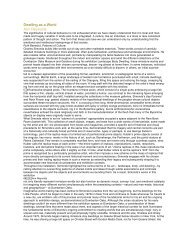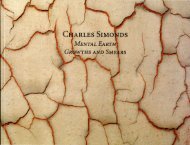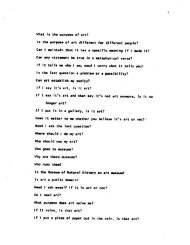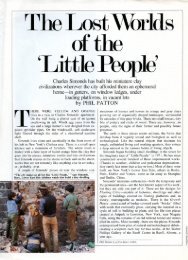Read Catalog - Charles Simonds
Read Catalog - Charles Simonds
Read Catalog - Charles Simonds
You also want an ePaper? Increase the reach of your titles
YUMPU automatically turns print PDFs into web optimized ePapers that Google loves.
miniature landscape and dwellings was the skyline of Manhattan. One could<br />
not avoid comparing the different architectures and the way they related to<br />
their respective landscapes. Implicit in the physical comparison was a contrast<br />
in the social and economic structures that had generated the architectures.<br />
The dwellings of the Little People held to the landscape, while the buildings of<br />
Manhattan seemed by comparison emphatic impositions on it, in opposition<br />
to the essential horizontality of the earth. At P.S. r as elsewhere, the forms<br />
employed by <strong>Simonds</strong> to represent the Little People are technologically nai:ve,<br />
while those of our society are not. The buildings of the Little People suggest<br />
in their casual disposition accretive growth, while ours conform to a logical,<br />
predetermined pattern. The comparisons are more numerous and the implications<br />
more elaborate, but they can be distilled into the assertion that the<br />
architecture of the Little People represents a culture that is more responsive<br />
to the physical environment than ours. Functioning thus as indicia of how<br />
people live, <strong>Simonds</strong>'s works seem more the musings of a cultural geographer<br />
than the gestures of a conventional image-maker. The sense of gratuitousness<br />
that might at first be felt before the work is dispelled by a more lasting recognition<br />
that these pieces are most consciously rendered, and are meditations<br />
on the relationship between the physical characteristics of landscape, the<br />
body, and architecture on the one hand, and the intangible elements of culture<br />
on the other.<br />
The identity between landscape, body, and dwelling was first postulated by<br />
<strong>Simonds</strong> in a series of films made in the early 1970S. Birth (see pl. r), in which<br />
<strong>Simonds</strong> emerges naked from the clay, reveals a belief in the earth as the<br />
source of all life. In Body - Earth (see pl. 2), <strong>Simonds</strong> uses the movements<br />
of his body to create contours in the ground, suggesting the relationship between<br />
earth forms and body forms. And in Landscape - Body - Dwelling<br />
(see pl. 3), <strong>Simonds</strong> lies naked on the earth, covers himself with clay and<br />
sand, and transforms himself into a landscape on which he builds a group of<br />
dwellings that conform to the contours of the body-earth. There is a kind of<br />
pathos to these films, as <strong>Simonds</strong> endeavors to merge his body with the landscape<br />
and subsume his male sexuality to the more androgynous character of<br />
the earth. Though his union with the earth is thwarted, the attempted conjunction<br />
of the body, the landscape, and architecture represented by the private<br />
ritual of Landscape - Body - Dwelling endures as one of the essential<br />
starting points of <strong>Simonds</strong>'s art.<br />
<strong>Simonds</strong> has incorporated this identity not only into the content of his art,<br />
but into the process of his art-making as well. If how we live (as symbolized<br />
by the Little People) is an expression of where we find ourselves, then how<br />
<strong>Simonds</strong>'s art looks and what it means is conditioned by where it is made. This<br />
has given rise to a divergence in the forms of his work as they relate to the<br />
miniature civilization. The Little People first appeared in temporary landscapes<br />
and dwellings on the streets of New York's Lower East Side; they subsequently<br />
found their way around America and throughout the world with<br />
<strong>Simonds</strong>, to Paris, Genoa, Berlin, London and, more recently, Guilin (fig. 2)<br />
and Shanghai. At the same time, the Little People have been the subject of<br />
temporary works that <strong>Simonds</strong> has executed for special exhibitions, such as<br />
Documenta in Kassel or the Projects gallery of the Museum of Modern Art,<br />
New York. They have also been the focus of permanent pieces for museum<br />
and private collections. To those observers who would make <strong>Simonds</strong> the<br />
27












